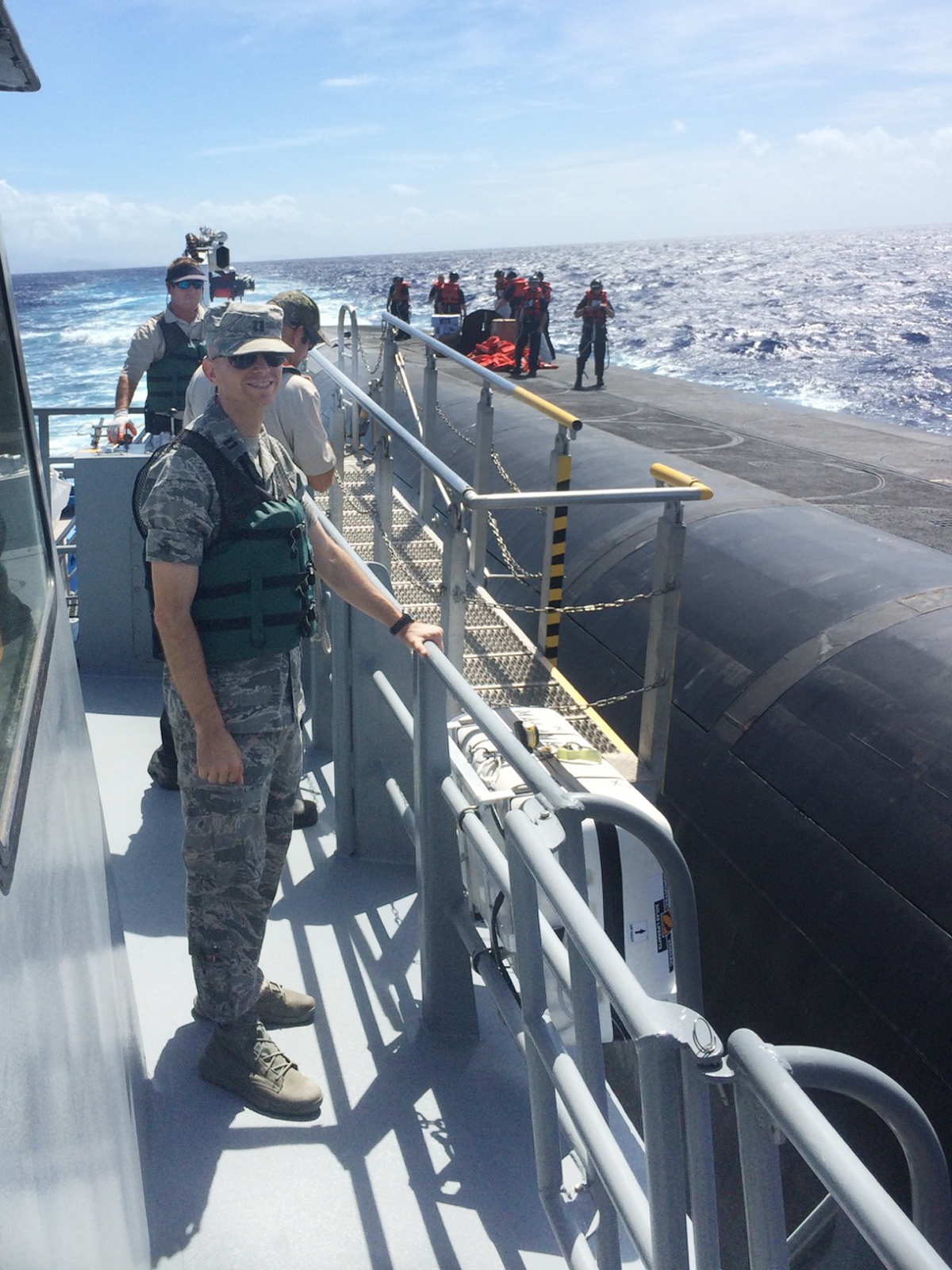U.S. Strategic Command Public Affairs / Published October
09, 2015
OFFUTT AIR FORCE BASE, Neb. (AFNS) -- Through the Striker
Trident nuclear officer exchange program, four hand-selected intercontinental
ballistic missile officers assigned to various Air Force Global Strike Command
units are broadening their horizons by serving multi-year tours with U.S. Navy
Submarine Forces ballistic missile submarine (SSBN) units.
The recently-implemented program enables Navy and Air Force
nuclear-qualified officers to gain an expanded view of the nuclear triad, as
well as each leg's respective role in U.S. Strategic Command's deterrence
mission. The four Air Force officers selected for the initial exchange are
gaining first-hand experience with SSBNs, the most survivable leg of the
nation's strategic forces.
"It is a great honor to be selected in the first group
of participants in this program," said Capt. Patrick McAfee, who is
serving a three-year assignment as a targeting assistant in the strategic
forces, nuclear weapons and force protection directorate at Commander,
Submarine Force, U.S. Pacific Fleet at Joint Base Pearl Harbor-Hickam, Hawaii.
COMSUBPAC is also designated as USSTRATCOM's Task Force 134.
"After serving in ICBM operations and maintenance at
two missile wings, I was interested in broadening my knowledge of strategic
operations," he said. "I have already benefitted from learning about
the complementary roles of ICBMs and SSBNs."
Before entering the exchange program in November 2014,
McAfee was assigned to the 341st Missile Wing at Malmstrom Air Force Base,
Montana. He credits his father's service in the Navy for his eagerness to apply
for the program and learn about SSBN and Navy operations, saying that "it
seemed like a great opportunity to join my Air Force experience with my Navy
roots."
Capt. John Mayer said his time with a Navy unit has
reinforced his appreciation for the importance of teamwork. In December 2014,
he began a two-year assignment as an assistant strategic targeting officer in
the strategic forces directorate at Commander, Submarine Force, U.S. Atlantic
Fleet in Norfolk, Virginia. COMSUBLANT is also designated as USSTRATCOM's Task
Force 144.
After leaving 20th Air Force headquarters at F.E. Warren Air
Force Base, Wyoming, Mayer immediately noticed the close proximity in which
SSBN crew members work.
"When you put more than one hundred men and women in a
submarine underwater, in dangerous conditions with a challenging mission, good
leaders can't help but build good teams," he said. "With everyone's
safety dependent on the competence of their shipmates, a lot of good dynamics
develop."
He went on to describe the operations of an ICBM crew, which
often differ greatly from those in the SSBN community.
"An ICBM team might be composed of one missile combat
crew member talking to a team chief 20 miles away and a missile maintenance
operations center controller a hundred miles away; but they will likely never
meet face to face," he said.
Capt. Cody daMota left the 91st Missile Wing at Minot Air
Force Base, North Dakota, to serve his three years of "sea time" as
an assistant nuclear weapons surety officer in COMSUBPAC headquarters'
strategic forces, nuclear weapons and force protection directorate. He arrived
at Joint Base Pearl Harbor-Hickam in May and said the program has already
enabled him to see the mission through a wider lens.
"As young (company-grade officers and junior officers),
we have a pretty narrow perspective on nuclear operations that is pretty much
limited to what we do in our day-to-day jobs," he said. "This program
has already significantly broadened my perspective.”
He also predicted that participants, present and future,
will benefit from the experience and bring new ideas back to their respective
wings and submarine groups, strengthening the deterrence force.
"I believe this program will provide an increased level
of knowledge and appreciation for the bigger strategic picture and how everyone
fits into it," he said. "This in turn will lead to higher job
satisfaction and increased morale."
DaMota described his selection for the initial Striker
Trident exchange as "a great honor," while acknowledging the
responsibility that comes with the unique opportunity.
"We are breaking new ground in this assignment and
charting a course for our successors," he said. "Our work here will
set the tone for many years to come."
Like Mayer, Capt. Jessica Tiffany is serving as an assistant
targeting officer in the strategic forces directorate at COMSUBLANT in Norfolk,
Virginia. She started her three-year Striker Trident exchange in May, after
serving with the 341st Missile Wing at Malmstrom AFB.
She said that she saw a new and unique opportunity to serve
in a joint nuclear environment and decided to apply for Striker Trident. She
also noted how the program provides participants a fresh look at how their counterparts
conduct deterrence operations and said she hopes to have some impact on the
program for future Striker Trident members, where I can help make the program
better.
"There are plenty of reasons a service does things one
way or another," she said. "Sometimes the answer is 'because we've
always done it this way' and with the changes to the nuclear enterprise, we
(the Air Force and Navy) can make improvements to better accomplish
USSTRATCOM's mission."







No comments:
Post a Comment